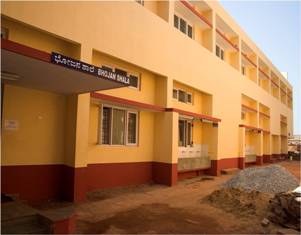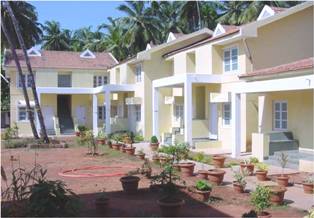Shrī Chitrāpur Mat̲h̲, Bengaluru
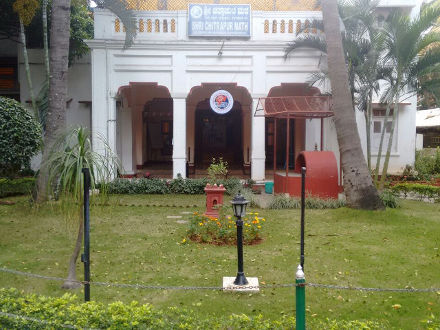
Timings - The Math - 7.00 am to 1.00pm AND 3.00 pm to 9.00 pm on all days. The Office - Mon. Thu. & Fri. from 6.00 pm to 7:30 pm
For Location & Contact details click Here.
In 1953, some Chitrapur Saraswats were inspired by Parama Pujya Shrimad Anandashram Swamiji to acquire property in the name of Lord Bhavanishankar, the presiding deity of Shri Chitrapur Math, Shirali, North Karnataka. Initially, when the Math was established, it was used as a summer retreat and transit accommodation for Parama Pujya Shrimad Anandashram Swamiji. Gradually, all socio-religious activities were shifted to the Math.
Over time, as more and more Bhanap-s, both young and old, began connecting with the Math, some renovations – one in 1973, another in 1996, and the third in 1999-2000 with an expansion in 2002 were undertaken at the Math while retaining its quaintness. These renovations resulted in a charming structure consisting of a beautiful courtyard, ‘Parijnanashram-Sabhangana’, with a sprawling garden; a spacious main hall named ‘Anandashram-Sabhagriha’; a smaller hall in the courtyard for Prasada-bhojana; a Yajnashala, and accommodation for Parama Pujya Swamiji and His retinue.
The Math has played an important role in the history of our Chitrapur Saraswat Samaja:
- Sadhana Navaha (1956): A 9-day long satra was held for the first time during the visit of Parama Pujya Shrimad Anandashram Swamiji. Inaugurated on 14th January, the satra included Pavamana-abhisheka, Samudayaka-gayatri-japa, Navachandi-homa, Laghu-rudra, and Grama-bhiksha on the 21st. The Lalaki-utsava that night was the first of its kind in Malleswaram.
- Parama Pujya Shrimad Anandashram Swamiji observed Chaturmasya Vrata here in 1956, 1959, 1964, and 1966
- Mahasamadhi of Parama Pujya Shrimad Anandashram Swamiji: On September 16th, 1966, at around 9 PM, the holy precincts of the Math reverberated with three resonant "Omkar-s", as Pujya Swamiji attained Mahasamadhi. The Mortal (Parthiva) Remains were taken to Shirali and interred alongside the other Samadhi-s as per His wish. To this day, one can feel the vibrations of the Omkar-s in the Samadhi room.
- Chitrapur Commercial and Housing Complexes: In the mid-1970s, Chitrapur Math, Shirali was in need of additional revenue as it depended solely on the annual vantiga to carry out its daily viniyoga-s. Parama Pujya Shrimat Parijnanashram Swamiji III had the foresight to utilise the land around the Bengaluru Math to build a commercial complex, which would stabilise the Math finances. In 1979, the then Local Sabha undertook the construction of a six-storey Chitrapur Commercial complex on the land facing 8th Main road. The complex proved to be a "Kamadhenu" for the Math at Shirali, having made it self-sufficient.
The land alongside the Math, facing 15th Cross road, was leased out to the Shri Chitrapur Co-op. Housing Society to construct an eight-storey, 96-apartment complex. This eased the housing shortage in a fast-growing Malleswaram. - Parama Pujya Shrimat Parijnanashram Swamiji III observed Chaturmasya Vrata here in 1959, 1964, 1966, and 1978.
- Mahasamadhi of Parama Pujya Shrimat Parijnanashram Swamiji III: On 29th August, 1991, Parama Pujya Shrimat Parijnanashram Swamiji III attained Mahasamadhi. The Mortal (Parthiva) Remains was kept in the Math from 3:00 PM to 5:30 PM for devotees to pay their last respects, and then flown to Mumbai by a chartered flight.
- Gayatri Purascharana Homa: For Guru-prapti, the Chitrapur Saraswat Samaja took a Sankalpa for the first Gayatri-purascharana-homa in December 1992. It was followed by Shatachandi-homa. Parama Pujya Shrimad Iswaranand Giriji Maharaj of Mt. Abu was invited to inaugurate the Purascharana. The next year, the second Gayatri-purascharana was followed by Sahasra-modaka- archana.
- After the Ordination of Parama Pujya Shrimat Sadyojat Shankarashram Swamiji, the 11th Mathadhipati of Shri Chitrapur Math, Shirali, Parama Pujya Swamiji visited Bangalore Math (after Pattabhisheka) for the first time, in December 1997 for Gita Jayanti. Parama Pujya Shrimad Iswaranand Giriji Maharaj was also present for the occasion.
- In 1998, Parama Pujya Shrimat Sadyojat Shankarashram Swamiji observed the Chaturmasya Vrata at Bengaluru Math. Pujya Swamiji's grace, knowledge, and love brought about a transformation in devotees of all ages. During the two months of Chaturmasya, Pujya Swamiji performed puja-s every morning and night. He taught the devotees to chant the ritualistic Sanskrit shloka-s with Him so that everyone experienced a sense of involvement. The 'group chanting' creates a divine atmosphere in the Math.
- Chaturmasa of 2008: Parama Pujya Shrimat Sadyojat Shankarashram Swamiji observed the Chaturmasya Vrata here in the tercentenary year of Shri Chitrapur Math. Among many activities, prominent was the announcement of Chitrapur Yuvadhara Foundation Day by Pujya Swamiji on 20th August, 2008, the Punyatithi of Parama Pujya Shrimat Parijnanashram Swamiji III.
- Samadhi-Kooda: This room is on the ground floor. This is where Parama Pujya Shrimad Anandashram Swamiji attained Mahasamadhi. No changes have been made since His time, in the way it is furnished. The uniqueness of this room is the peace of mind it affords. The reverberations of the last "Omkar-s" still resound, not only in this room, but in the entire hallowed edifice. Many Mahatma-s and intellectuals have expressed this as a reason for their visiting our Math and giving discourses.
- The Library: The Math Library houses hundreds of books on spiritual topics. Having been reorganised and revamped, it was reopened to the devotees on 1st March, 2018.
- Deva-Kooda: There are vigraha-s of various deities, an idol of Shri Adi Shankaracharya, and Paduka-s of Parama Pujya Shrimad Anandashram Swamiji and Parama Pujya Shrimat Parijnanashram Swamiji III. It also has photographs of Parama Pujya Shrimat Pandurangashram Swamiji, Parama Pujya Shrimad Anandashram Swamiji, Parama Pujya Shrimat Parijnanashram Swamiji III, Parama Pujya Shrimat Sadyojat Shankarashram Swamiji. Since 2016, grihasta-s have been performing puja-s here and at other Sannidhi-s every morning.
- Other Sannidhi-s: The courtyard has Nagadevata (Pratishthapana done by Parama Pujya Shrimat Sadyojat Shankarashram Swamiji on 20th Jan., 2011) and Daiva Sthana-s- Annamma, Chamunda, and Marikamba.
Mornings: Gayatri-anushthana by Purusha-varga and
Bhashya-pathana classes for registered participants,
Evenings: Bhajana-s, chanting of the Dipanamaskara and Shri Padashtaka, and Arati.
Mondays (5:30 PM onwards): After stotrapathana, one chapter of Shrimad Bhagavad-gita and the Mrutyunjayajapa are chanted, followed by Dipanamaskara, Ninada, and Shiva-pujana by grihasta-s.
Tuesdays: Talk by Dr. Sudha Tinaikar (4 PM to 5 PM)
Wednesdays: Chanting of Dipanamaskara at 6:30 PM
Thursday (5:30 PM onwards): Pathana of one chapter of Shri Chitrapur Guruparampara-charitra and chanting of Shri Parijnanashram-trayodashi, bhajana-s, Shri Shankaranarayana-gitam, and Dipanamaskara. This is followed by Ninada and performance of Guru-pujana by grihasta-s.
Friday (5:30 PM onwards): A different stotra is chanted each week, such as Navaratri-nityapatha, Lalita-sahasranama, Saundarya-lahari, or Devi-anushthana, followed by bhajana/stotrapathana, Dipanamaskara, Ninada, and Devi-pujana by grihasta-s.
Saturdays (5:30 PM onwards): Chanting of Vishnu-sahasranama, a chapter of Shrimad Bhagavad-gita, Ramaraksha-stotra, Hanuman-chalisa, Ramanama, and Dipanamaskara.
In addition, Samaradhana of our revered Purvacharya-s and some special days mentioned in the next section (marked ‘+’) are observed with Dipanamaskara, Bhashya-pathana, Ashtavadhana-seva, Arati, Prasada-vitarana along with regular Pujana on Mondays, Thursdays, and Fridays in the evenings.
- Chitrapur Rathotsava on Chaitra Purnima
- Shri Shankara-Jayanti: To commemorate the occasion of Shri Shankara-jayanti, essay writing, recitation, and drawing and painting competitions are organised for all Varga-s since the year 2000. Shri Shankara-jayanti is celebrated on Vaishaka-shukla-panchami. The Chief Guest unveils the drawings and paintings, prizes are distributed to the winners and participants of the competitions, and the chief guest gives a talk. This is followed by Dipanamaskara, Bhashya-pathana, Shri Shankaracharya-pujana and Prasada-vitarana.
- Janmotsava of Parama Pujya Shrimat Parijnanashram Swamiji III: Observed on 15th June
- Samaradhana of Smt. Umabai Aroor: Observed on Yogini Ekadashi day
- Shayani Ashadha-Ekadashi: Observed with Akhanda-bhajana, Vithobha-arati and Prasada-vitarana.
- Chaturmasya: This is a busy period with different kinds of spiritual activities
- Vyasa-purnima or Guru-purnima, Upakarma, Naga-panchami, Gokulashtami, and Punyatithi of Parama Pujya Shrimad Anandashram Swamiji are some of the important events observed in this period. Special talks and cultural programmes are organised every Tuesday, Wednesday, Saturday, and Sunday from 5.30 PM to 6.30 PM.
- Simolanghana is also observed in large numbers.
- Gokulashtami: Ashtami mhantyo are sung for eight days and the Krishna idol at the Math is decorated differently every day. The cradling ceremony of Lord Krishna is observed on Krishna-Janmashtami. The next day, "Gopal Kallo" is celebrated with tiny tots dressed as Krishnas, Radhas, Gopis, and Gopikas. The kids also participate in a handi breaking ceremony.
- Samaradhana of Parama Pujya Shrimad Anandashram Swamiji: Samuhika Shrimad Bhagavad Gita Pathana commences a week prior to the Samaradhana. A day before Samaradhana, in addition to Pathana, Bilvarachana is performed with recitation of Swami Anandashram Ashtottara. On the occasion of the Samaradhana, the “Samadhi-kooda” is beautifully decorated with flowers in the evening. Bhajana-s are sung along with Dipalankara. This is followed by observance of Mauna.
- Swarna-Gauri-Vrata and Ganesha-Chaturthi: Samuhika Gauri-Ganesh-pujana and Samuhika-ganahoma are performed.
- Navaratri: Observed with Navaratr-nityapatha, stotrapathana, Devi-anushthan, Bhajana, and Shri Devi-pujana. Kumarika-pujana is performed on Navami Day.
- Kojagari-Purnima: Celebrated with Dipanamaskara, Devi-pujana, and Kheer-vitarana.
- Pratishtha day of the statue of Parama Pujya Shrimad Anandashram Swamiji: A beautiful marble statue of Pujya Anandashram Swamiji was donated by Shri Kallianpur Shivrao in 1967. The Pratishtha day is observed on Kartika-shukla-dashami every year.
- Jagarani-Ekadashi: Observed with Akhanda-Bhajana, Vithobha-Arati, and Prasada-vitarana
- Dipavali: Observed with Dipanamaskara, Ninada, performance of Dipavali Shri Lakshmi-pujana
- Kartika-Purnima: The laity participates in Samuhika Durga-Namaskara followed by Prasada-bhojana.
- Janma-Divas of Parama Pujya Shrimat Sadyojat Shankarashram Swamiji: Bhashya Pathana is rendered.
- Gita-Jayanti: Shrimad-Bhagavad-Gita Recitation competitions across all age groups are conducted. On Margashira-shukla-ekadashi, Shri Gita-jayanti is observed with Samuhika-Shrimad-Bhagavad-Gita-pathana and Gita-pujana in the morning. In the evening, a chief guest distributes prizes and gives a talk. After Dipanamaskara, Bhashya-pathana is rendered.
- Vardhanti of Sannidhi-s: On Krishna-pratipada of Pushya-masa, puja-s are performed at Naga, Annamma, Chamunda, and Marikamba Sannidhi-s on the occasion of their Vardhanti.
- Pattabhisheka-Vardhanti of Parama Pujya Shrimat Sadyojat Shankarashram Swamiji
- Shishya-Sweekara-Divas of Parama Pujya Shrimat Parijnanashram Swamiji III on March 1st
- Shivaratri: Sadhaka-s take part in the Char-yama-Shiva-pujana which begins at 10 PM and concludes at 5:15 AM.
- Girvanapratishtha:
Aradhana / Sadhana / Dharana Varga are conducted by teachers at scheduled times. Sambhashan classes for the laity every Thursday (10:30 - 11:30 AM). Staravardhanam class for teachers are conducted on 1st and 3rd Fridays. - Prarthana-varga classes are conducted every Saturday (4 - 5 PM).
- Yuvadhara activities, ranging from Shrama-seva and Devi-anushthana to interest-based workshops are conducted on scheduled days.
- Ashtanga-Yudh and rebounder sessions are conducted every Friday (after Devi-pujana) and Saturday (after Dipanamaskara).
- A Samvit Sudha counter, which is open on Tuesdays, Thursdays, and Saturdays (4 - 6 PM).
- Shri Chitrapur Bhajan Mandali (started in 1982), Guru Shakti (comprising the Purusha-varga) and Shiva Shakti Bhajan Mandali meet at the Math to learn and practise bhajana-s on scheduled days.
Bengaluru is well-connected to all corners of the country by road. Apart from the State Transport buses, a large number of luxury coaches are also available.
Rail
The nearest railway stations are Bengaluru City Junction, Majestic and Cantonment Railway Station, Vasantnagar. Auto-rickshaws and buses are available to reach the Math from either of the railway stations.
Air
The nearest airport is Kempegowda International Airport, Devanahalli. Buses and cabs are available to reach the Math.
Accommodation
While there is no accommodation for visitors at the Math, there are hotels and lodges within a 5 km radius.
Places of Interest close to Bengaluru Math
Shri Durga Radha Krishna Mandir (1.1 km from the Math, on 11th Main, Malleswaram): Parama Pujya Shrimat Sadyojat Shankarashram Swamiji installed a Durga idol in May 2013. There are several other temples in the vicinity of the Math.
Bhandikeri Mat̲h̲, Gokarn
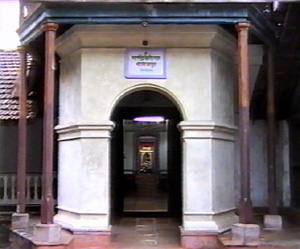 The Samadhi of our first Guru, H.H. Shrīmat Parijnanashram-I Swamiji is located here.
The Samadhi of our first Guru, H.H. Shrīmat Parijnanashram-I Swamiji is located here.
Gokarn is considered, as much a holy place –Teertha Kshetra - as Kashi is. Situated in coastal Karnataka, this ‘temple town’ has a lot of religious and mythological significance. Besides the branches of Kavle and Parthagaali Math, other well-known temples are found in Gokarn like the Mahabaleshwar Temple, Maha Ganapathi, Tamra-Gauri, Venkataramana, Uma-Maheshwari, Varadraj, Bhadrakali, and many others. The Kotiteertha is a beautiful lake surrounded by temples, and a small platform in the centre.
About 400 years ago, Saraswat Brahmins who fled from the Gomantak to escape forcible conversions by the Portuguese and Christians, came down and settled in and around Gokarn. About 4 kms. north of Gokarn is Bankikodla, earlier known as the ‘Vilayat of Bhanaps’.
For us Chitrāpur Saraswats, Gokarn has a special significance, because it is here that our glorious Guru parampara began, almost 300 hundred years ago.
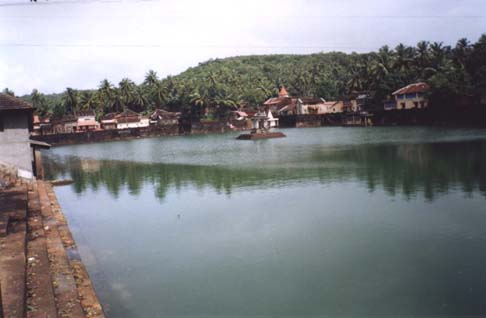 Kotiteertha was the site of penance performed by senior members of our community, for want of a ‘Guru’ to guide the community. How H.H. Adi Parijnanashram Swamiji arrived there, etc. is well known history, recorded elsewhere. Swamiji brought with Him in His ‘Jholi’ the beautiful idol of Lord Bhavanishankar, which has thence become the ‘Pradhan Araadhya Daivata’ of Chitrāpur Saraswats
Kotiteertha was the site of penance performed by senior members of our community, for want of a ‘Guru’ to guide the community. How H.H. Adi Parijnanashram Swamiji arrived there, etc. is well known history, recorded elsewhere. Swamiji brought with Him in His ‘Jholi’ the beautiful idol of Lord Bhavanishankar, which has thence become the ‘Pradhan Araadhya Daivata’ of Chitrāpur Saraswats
As per the ancient lay-out, the main entrance to this temple-town was by the so-called ‘Bhandi Keri’ (lane for carts), leading to the south-east corner of Kotiteertha. It is here that our Gokarn Math is situated, facing ‘Bhandikeri’. The road leading to the main gate was first made in 1932 and renovated in 1998 to commemorate H.H. Sadyojāt Shaṅkarāshram Swamiji’s visit.
The frequently used entrance to the Math from Kotiteertha side is actually the rear entrance.
Bhandikeri Math: The Gokarn Math, also known as the Bhandikeri Math, is located a few metres away from Kotiteertha. It is said that originally, this was the Uma-Maheshwar Temple. It became a ‘Math’ after H.H. Adi Parijnanashram Swami made it His abode and later took Mahasamadhi there. The prabhavali of the Umamaheshwari idol has an inscription –Gersappe – leading to the belief that it has been brought to Gokarn from elsewhere. There is a narration that H.H.Krishnashram Swamij in His dream was told of this lying unattended in a forest in Gersappe, near Shimoga. He then went and brought it, to be installed at the Math.
The Uma-Maheshwari Shrīne stands at the centre of the quadrangle enclosed by the Chandrashalas of the present Math. The Vigraha faces the direction of Kotiteertha, the Samadhi Shrīne faces the main gate Bhandikeri side.
Math. The Vigraha faces the direction of Kotiteertha, the Samadhi Shrīne faces the main gate Bhandikeri side.
Major renovations to the Bhandikeri Math and the consecration of the Hodi Samadhi took place in May 1928, under the direct supervision of H.H. Shrīmat Anandashram Swamiji.
Swamiji observed Chaturmas at Bhandikeri in 1937 and 1954.
The Toggu Math: This lesser known place is of great historical significance. It is situated opposite the Patta Vinayak or Batta Ganapati temple, to the left, on the way from Kotiteertha to our present Math. It is believed that when our elders first met the Sage from Kashmir at Kotiteertha (1708), they welcomed Him as their God-sent Guru and took Him to the nearby shrine opposite the Ganapati temple. They made this the first holy Abode of their Adi Guru. It was subsequently known as ‘Toggu Math’, the ‘higher Math’ being the present Bhandikeri Math which enshrines the sacred Adi Samadhi.
Toggu Math houses the Vigraha of Kashi-Vishweshwara.
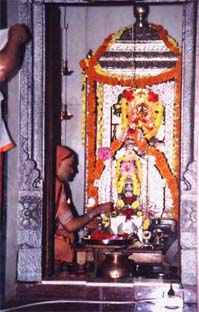 H.H. Swamiji observed chaturmasya vratam at the Gokarn Math from July 5,2001 upto Sep. 2, 2001.
H.H. Swamiji observed chaturmasya vratam at the Gokarn Math from July 5,2001 upto Sep. 2, 2001.
Projects carried out
- Repairs and Renovation of Samadhi temple
- Tamrashasan to Samadhi Room Roof
- Rooms for Parama Poojya Swamiji's accommodation and for the retinue
Gokarn is situated 36 km from Kumta, and 25km from Ankola, off the National Highway 17.
Buses ply to and fro from Kumta every hour, the first at 7.00 a.m. and the last at 7.30 p.m.
The nearest Railway Station is Gokarna Road, 6 kms from the town, on the Konkan Railway Mumbai – Mangalore route.
At present, no guest house facilities are available at the Bhandikeri Math, but some accommodation can be made available in near by hotels or lodges. Arrangements for meals can be made if prior intimation is given.
11.00 a.m. Noon Pooja,
7.00 p.m. Deepa-namaskars,
8.00p.m. Night Pooja
:Vanabhojan on ‘Chaitra Krishna Trayodashi’ Punyatithi of H.H. Parijnanashram Swami – I, when idol of Lord Bhavanishanker is taken in a procession to Shrī Varadaraj Temple through the Bazaar Street.
Shri Durga Parmeshwari Temple, Karla
The Samadhi of our Tenth Guru, H.H. Shrīmat Parijnanashram Swamiji III is located here
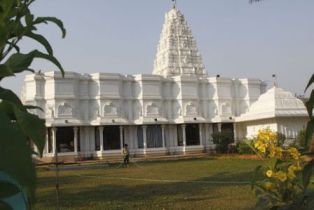
Swami Parijnanashram III was initiated into Sanyas at a grand ceremony at Shivaji park, Mumbai, on 1st March 1959 as the tenth in the lineage of the glorious Chitrāpur Guruparampara. On 12th October, 1967, Swamiji ascended the Peetha at an Ordination Ceremony at Shirali and became the tenth Mathadhipati of the Shrī Chitrāpur Math Samsthaan.
In addition to the traditional religious chores of the Chitrāpur Samsthaan, Swamiji with insight into things spiritual (Paramartha), and things mundane (Vyavahara), devoted attention to the social, economic, educational and other welfare needs of the Community.
To take care of the old and infirm members of the community one of the initial humanitarian projects which Swamiji undertook was the construction of a compact, cosy and cohesive habitation – ‘The Anandashraya’ at Chitrāpur, Shirali.
He established a deer park, and a bird sanctuary on the spacious grounds of the Govardhan hillock, a wireless centre, weather observatory, art gallery, and a pathological Laboratory at Panchavati. With His foresight, He took in hand the building of a ‘Commercial Complex’ on the vacant land around the Math in Bangalore, which has resulted in a continuous revenue for the Chitrāpur Math.
In 1973, He revived the glorious Chitrāpur Rathotsava, which had been discontinued from 1939 due to financial restraints.
He moved to Karla, near Mumbai, in the early eighties, and made it His Abode till His Mahasamadhi.
Swamiji’s keen desire to uplift the poor and needy continued with the formation of the Shree Trust, a charitable Organisation. Under it’s aegis, He founded the ‘Swami Parijnanashram Educational and Vocational Centre for the Handicapped’ at Bolinj, near Virar. The Institution is being run in collaboration with the Central Government and has five departments for the Deaf & Dumb, mentally retarded, orthopaedically handicapped, and blind, and caters to the educational needs of poor children, irrespective of caste and creed.
Swamiji inspired the devotees to establish another Trust at Karla, called the Shree Shantta Sukhada, to serve the tribals and local inhabitants
The Karla Math started as an Ashram, built on a plot purchased for Swamiji. The love and respect He received from the members of the community was evident from the large number of visitors to the Ashram. He encouraged the youth to start the ‘Datta-Jayanti’ festival at Talmakiwadi, Mumbai. This tradition continues to date, and the Celebrations have been graced by His successor to the Chitrāpur Peetha, H.H. Sadyojāt Shaṅkarāshram Swamiji, ever since he ascended the Peetha.
Swami Praijnanashram attained Mahasamadhi at Bangalore on 29th August 1991. The mortal remains were brought to Mumbai that evening by air, and placed at the Khar Math during the night for Darshan. The next morning they were taken to Karla and amidst recitations from the Upanishadhs, Shree Purushasuktas and Shree Rudrasuktas, Swamiji was given Samadhi, seated in the ‘Anushtaan’ position.
Swamiji’s earnest desire to have a Dhyan Mandir and instal Devi Durga Parmeshwari’s idol was fulfilled in February 1993. A beautiful Temple with a majestic Gopura, was built alongside the Ashram, housing the Samadhi. The idol of Godess Durga Parameshwari was led in a procession from the foot of the Ekvira Hill and piously installed at the temple in conjunction with a Shata Chandi Homa.
Linga Prathishtha was performed at the Samadhi at the same time. During excavation of the Samadhi, two marigolds (zendu) were found, fresh and fragrant at a depth of 3 to 4 feet! A little deeper, Swamiji’s mastak, and still below, His body, appeared intact. The exposed Mastak was thereafter kept for Darshan for the whole day. The Samadhi was refilled after the Linga Prathishta.
Road: The Samadhi Math at Karla is 100kms from Mumbai and 80 km from Pune on NH4 Mumbai-Pune section. It is seen as you pass the junction leading to the Karla caves. Most ST buses stop at the Junction
Rail: Nearest Station is Malavali railway station, if you wish to reach Karla by local train(shuttle) from Pune or Lonavala.
From Mumbai, all trains halt at Lonavala which is one station before Malavli.. Change over to a Pune-bound local (shuttle) at this station.
Autorickshaws are available at both Malavali and Lonavla railway stations.
Rooms at Arogyadham are available for short stay. Meals are arranged if advance intimation is given.
For Location and Contact details click Here
Guru Mat̲h̲, Mallapur
Mallapur (originally known as Mallinathpur) is in a valley with greenery all around. Visitors find solace in this sanctified quiet village.
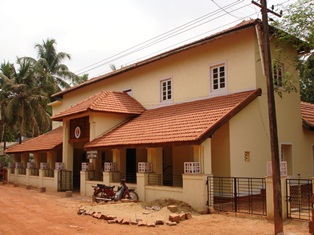 Here is the samadhi of H.H. Shrī Shaṅkarāshram Swamiji II (fourth in the Guru Parampara). He belonged to the Shukla Bhat family of Mallapur. A Yogi of the highest order, during illness (Malaria) He could transfer the fever to the 'Danda' and perform His Anushthana. He is regarded as an incarnation of Lord Dattatreya.
Here is the samadhi of H.H. Shrī Shaṅkarāshram Swamiji II (fourth in the Guru Parampara). He belonged to the Shukla Bhat family of Mallapur. A Yogi of the highest order, during illness (Malaria) He could transfer the fever to the 'Danda' and perform His Anushthana. He is regarded as an incarnation of Lord Dattatreya.
Daily Swamiji used to go for a walk to Hoovinhittal near Chandavar and sit there for long hours in meditation amidst a 'Mogre' flower garden. People used to wait on the road side for his darshan and blessings. He would point out his finger at any one bhanap who could then perform 'bhiksha sevaa' on that day. Swamiji preferred Pej and payas.
The special seva offered at the Samadhi here is 'Ksheeraanna Sewa". There is a story behind this. As Shaṅkarāshram Swamiji's health was not too good, he had been advised a diet of Pej (Ksheeraanna). It was the day of the Punyatithi of Parijnanashram Swamiji II (i.e. His Guru). Pej had not been prepared as per the instruction of Shishya Keshavashram Swamiji. So Shaṅkarāshram Swamiji was not served the routine diet of 'pej'.
When the cooks in the kitchen started frying ' vade ', they found to their dismay that all the vade would stick to the bottom of the frying pan and would not get fried! When some devotees gave the news to Shaṅkarāshram Swamiji, he exclaimed "as the jatharagni is intense here perhaps the vades are not frying"! (Implying that the fire in His stomach was intense). Everyone realized their folly. Hence 'Pejje Naivedya' is offered at this Jagrat Samadhi.
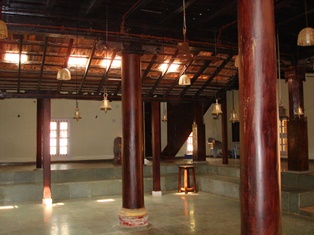
Earlier the samadhi was covered with a thatched roofing. It was Pandurangashram Swamiji who supervised the construction work of the Garbhagriha and chandrashala around it.
Electrical installation & 'Switching on' was done by H.H.Shrīmat Parijnanashram Swamiji on 5th june 1967. (Ref. Sunbeam, Sept 1967)
H. H. Shrīmath Sadyojāt Shaṅkarāshram Swamiji observed the Chaturmasya Vrata here in 1999. The Math vaastu has been renovated extensively as a part of the Tercentenary capital projects. The Mantapam around the Samadhi can now serve as an appropriate place for large Sabhas. Elaborate kitchen with an attached dining area has also been made as a part of this renovation project.
On the Goa-Mangalore National High Way (N.H.17) turn to east at Kumta Gibb High School circle via Herwatta road. At Kujalli (8 k.m.) take a right turn to reach mallapur (1.5 k.m.)
| Nearest Railway station | KUMTA (Konkan Railway) |
| Nearest Airport | MANGALORE |
| Nearest town | KUMTA (10 k.m.) |
Auto Rickshaws and taxis are available on hire at kumta. K.S.R.T.C. Bus timings from Kumta to Mallapur are 7.00, 9.00, 10.30, 12.00, 13.15, 15.00, 17.30 and 19.00
Bus route name is KUMTA-KONALLI
Accommodation : The Archak is kind enough to provide boarding and lodging.
Accomodation is also available at the Shrī Durga Datta Mandir and Avadi Math, adjacent to the Math.
Places of Interest :
Mallapur itself is a very beautiful village, quiet and serene. The atmosphere is peaceful and conducive to spiritual pursuits. There are three very important temples situated next to the GuruMath.
Shrī Ganapati temple
Originally this was Mallinatheshwar temple and this village was called Mallinathpur. This was an 'agrahara', a residential colony of brahmins. It is evident from a stone inscription at this temple that mallinathpur was given as a grant to 12 Brahmin families by one Basappa Nayak under the order of Harihara, the king of VijayNagar in 1304 Shalivahan Shaka. This temple was then dedicated to Mallinath (Shivalinga). Subsequently a Ganesh idol was found in Masur (near Kumta) and this idol was brought and installed in this temple. The year of the Pratishtha is not known. There is a reference that H. H. Keshavashram Swamiji's Shishya Sweekar ceremony took place in this temple.
The Sabha Mantap and Chandrashala were built in 1949. The temple structure needs uregent repairs. The Cost of this is expected to be arounf 2.5 lakhs. Donors are requested to come forward with a helping hand.
Avadi Math (GopalKrishna Temple)
Named after Avadibai (Laxmibai Narayan Ubhaya) disciple of Sri RamaVallabh Das, a Maharashtrian saint, who was a great Krishna Bhakta. Bhajans composed by Shrī RamaVallabh Das are known as 'Ashtami Mhanti' are sung here. In the temple have been installed the kaliamardan moorti presented to Avadibai by her Guru Sri ramaVallabh Das, a Kalasha representing Avadi Mata with a beautiful 'Mukha', and a hand raised in ;Abhaya Mudra' and a charming marble idol of Shrī Venugopal in standing posture.
Ubhayakars and Chandavarkars are the descendents of Avadibai and Diwan Narayanappa Nadkarni. He was honoured by Somshekar Nayak, ruler of the Keladi dynasty and made Narayanappa the administrator of two firkas (Chandavar & Gersoppa) and hence the family came to be known as 'Ubhayadavaru' and later Ubhayakars.
First Sthirpratishtha took place in 1842. The Temple faced the East. In 1942, a new garbhagriha facing north wa built by Shankar S. Chandavarkar.
Krishna Jayanti Utsav is celebrated from Shravan Bahula Pratipada to Trayodashi for the last 350 years.
A guesthouse with 8 rooms with all amenities is made available for the devotees.
Durga Datta Mandir
Shrī Durga Datta Mandir was founded by Shantappa Venkappa Nagarkatte (well known as Soiru Mhant) in 1910. Soiru Mhant while in prime youth and govt. service underwent rigorous saadhana in pursuit of Lord Dattatraya in Narsobawadi, Gokarna etc. He composed many abhags in Marathi in praise of Kuldevata Shantadurga and Dattatraya. The 'Sansara Yatra' written by him as well as other Abhangs, Bhoja stand preserved.
Soiru Mhant had 'devi darshan' at Sirsi Vithoba temple. Then onwards he could compose the bhajans continuously. These bhajans are sung during Navaratri and Datta Jayanti festivals.
The temple and guest house were constructed by late Shrī Sadanand B. Nagarkatte in 1980. The guesthouse has 5 rooms with all amenities.
Noon Pooja : 12.00 noon
Evening Pooja : 8.30 p.m.
Ganesh Chaturthi, Magha Chauthi at the MahaGanapati temple
Gokulashtami at the Avadi Math
Datta Jayanti and Navaratri at the Durga Datta Mandir
All Punyaytithis & vardhanti days are observed with Bhajans and Ashtavadhan Seva.
Ksheeraanna Seva is performed by a majority of the devotees.
Rudrabhisheka etc. can be performed as mentioned in Math Sevas under Chitrāpur math
For Location and Contact details click Here
Samadhi Mat̲h̲, Mangaluru
The Samadhi of our sixth Guru, H.H. Shrīmat Vamanashram Swamiji is located here.
H. H. Shrīmat Vamanashram Swamiji was ordained as a Shishya by H. H. Shrīmath Keshavashram Swamiji in 1804. He had the good fortune of conducting His yogabhyas under the able guidance of His guru. In 1823, Shrīmath Vananashram Swamiji became the Mathadhipati after Keshavashram Swamiji attained mahasamadhi.
He reigned as the Mathadhipati from 1823 to 1839. Shrīmat Vamanshram Swamiji was an embodiment of compassion, forgiveness and austerity. With total involvement and concentration in spiritual affairs Swamiji gave little time to administrative matters concerning the math. He entrusted the administrative matters of the math entirely to the Manager.
Shrīmat Vamanashram Swamiji attained Mahasamadhi while on a visit to Mangalore and the holy samadhi was provided in Mangalore town with tender coconut water Abhishek. To this day devotees facing difficulties offer worship and tender coconut water Abhishek at the Samadhi and obtain redress.
In 1999 June, in view of the leak in the floor of the samadhi a complete repairs and reconstruction project was taken up. The floor was covered with polished granite and the walls covered with marble. The linga was re-installed over the Samadhi. A new silver mantap was installed, replacing the old one installed by Shrīmat Anandashram Swamiji over 75 years ago.
Events of historical significance -
-
Ordination of H.H. Shrīmat Pandurangashram Swamiji was done at Mangalore in 1858.
-
Jeernoddhara of Shrīmat Vamanashram Samadhi and installation of Lord Bhavani Shankar idol at Mangalore Math in 1868.
-
1869 One of the earliest Mahasabhas: promulgation of the historic ‘1st vantiga shasana of Shukla samvatsara’, placing the matter of vantiga on a ‘statutary’ footing.
The math underwent a transformation when it was renovated prior to H.H. Shrīmat Sadyojāt Swamiji's Chaturmas in 2002. H.H. Shrīmat Sadyojāt Shaṅkarāshram Swamiji conducted his Chaturmasa here from July 2002 to September 2002.
The math is located at the GANAPATHI TEMPLE ROAD in Mangalore town. The telephone no. is 0824-2427212
Road
Mangalore is well-connected to all corners of the country by road. Apart from the State Transport buses a large number of luxury coaches are also available.
Rail
On the Konkan Railway line, the nearest railway stations are Kankanady or Mangalore Main. Autorickshaws, buses and other modes of road transport are available to reach the Math from either of the railway stations.
Air
The nearest airport is Mangalore and regular flights are available.
Accommodation
There is a hall with fans in the Samadhi Math. A limited number of beds are available. Two bathrooms and two toilets are attached. The hall below and above can accommodate around 50 members. Stay is restricted to 5 days only.
On the road behind the Math there are hotels where good food is available.
Places of interest
- Adjacent to the Samadhi Math is the Sri Umamaheshwara temple which is over 300 years old. In the precincts of the temple is the Subramanya Mandir which is over 200 years old this year. 3 years ago, H. H. Shrīmath Sadyojāt Shaṅkarāshram Swamiji had installed a new silver idol here. There is also the Datta Mandir which is over 210 years old.
- 30 k.m. to the South-East is the famous Shrīmath Anantheshwara temple at Vittala where the Car festival is celebrated on Marghashirsha Shashti. H.H. Swamiji graces the occasion.
- 3 k.m. to the east of Math is the Manjunatheshwara temple.
The Math doors open at 6 a.m. with Nirmalya Visarjan
Midday Pooja and Abhisheka is at 12.30 noon. The doors close at 1.00 pm.
Doors re-open at 5.30 pm. DeepNamaskars are at 7.00 pm with Abhisheka and Arati at 8.00 pm. The doors again close at 8.30 pm.
Every Friday evening Lalitha SahasraNama with kumkumarchana to the Sri Chakra at the Samadhi is done regularly by the Mahilas.
Anantha Chaturdashi
Gowri Tritiya & Ganesh Chaturthi
Rigupakarma
Tulsi Pooja
Shrī Vamanashram Punyatithi & Karthik Deepotsava on Karthika Navami
All Punyaytithis & vardhanti days are observed with Bhajans and Ashtavadhan Sewa.
Tender Coconut (shiyala) abhishek is performed by majority of the devotees.
Rudrabhisheka etc. can be performed as mentioned in Math Seva rates.
For Location and Contact details click Here
Shrī Chitrāpur Mat̲h̲, Shirali
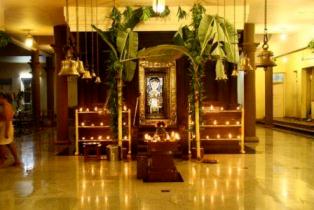 Amgelo Mathu... just the two words make our hearts yearn for that serene abode of our Guru Parampara. The façade of the Math at Shirali has assumed iconic importance for all Chitrāpur Saraswats.
Amgelo Mathu... just the two words make our hearts yearn for that serene abode of our Guru Parampara. The façade of the Math at Shirali has assumed iconic importance for all Chitrāpur Saraswats.
The current building of the Math was constructed during the times of Param Shrīmat Pandurangashram Swamiji. Aptly named as "Krishnashram Prasad" as a dedication to His Guru. The structure nearing a century was in need of repairs at many places and it was necessary to make way for new technology that will stand the test of times for another 100 years ahead. And what better occasion could there be than the Tercentenary year for completion of this entire project!
Keeping the interest of retaining original vaastu of Samadhi temples as untouched as possible, and in view of the sentiments attached to the façade, Param Poojya Swamiji set the task to the Architects that only exteriors of the Samadhis be touched with the view to make the structure stronger. Sthapatis- Architects specializing in design of Temples in accordance with Shastra were specially invited to contribute to this aspect.
Funds were raised by appealing to all Community members and people made commitments to contribute their best over a five-year period. Grace of Lord was evident as cash flow managed to keep pace with the expenditure. A total of Rs 451 million has been spent so far and some more amounts are yet to be spent.
As you enter the Math precincts now, the unchanged façade of the Math welcomes you. On your left is the new building of Office and Dhyan Mandir that came up in the year 2004. A new Vigraha of Lord Ramanjaneya gazes protectively at all those seeking entry into Math. This Vigraha was consecrated on 15th February 2008, along with the three new Shrīnes inside.
Kshetrapal- the Guardian Sentinel of our Vaastu, is located to your right, as you enter through the main gate. Kshetrapal sthan was earlier located inside the Math building, near the Maha Ganapati shrine and was consecrated at the relocated venue in 2007 April when the Inner renovation work of all Samadhi Shrīnes was completed.
As you enter the Main building, you find that the nagara and vajjap team is located in a cosy corner to your right in a more spacious and well-covered space. This team that religiously heralds each occasion, such as arrival of Param Poojya Swamiji into the Math, the Maha Aarati and also renders melodious music during Pooja and Ashtavadhan seva, is an important part of all functions as well as daily sevas.
When you cross the Main door, a large and a bright spacious hall greets you. The clean granite flooring, raised ceiling that brings in ample sunlight through skylight, large column that support the RCC ceiling, make it possible for more than 700 people to sit comfortably inside the temple to watch the proceedings. Chiming of an occasional bell marks the regular stream of devotees flocking for the Darshan and Dhool Bhet.
As you look straight ahead, the beautiful shrine of Lord Bhavanishankar greets you benignly. A new Nandi established in 2007, sits in alert position before His Master.
 As you look to the left, you are greeted by the three new Shrīnes- Shrīvalli Bhuvaneshwari, Maha Ganapati and Adi Shankaracharya. The Vigraha of Shrīvalli Bhuvaneshwari captivates your attention and now it is common sight to see Sadhakas immersed in meditation in front of this shrine for most parts of the day. Newly composed Ashatak in Her stuti forms a prominent part of our recitation in the evening Pooja schedule.
As you look to the left, you are greeted by the three new Shrīnes- Shrīvalli Bhuvaneshwari, Maha Ganapati and Adi Shankaracharya. The Vigraha of Shrīvalli Bhuvaneshwari captivates your attention and now it is common sight to see Sadhakas immersed in meditation in front of this shrine for most parts of the day. Newly composed Ashatak in Her stuti forms a prominent part of our recitation in the evening Pooja schedule.
A smiling Adi Shankara seated to Her right, benevolently goads the Sadhaka on the path of Rasamaya Sadhana. Mastering the knowledge of all four Vedas at a tender age of eight, He went on to rejuvenate Advait philosophy amidst an environment of doubt and disbelief 1200 years ago. A stuti consisting of seven stanzas extolling His achievements is now recited daily in the evening rituals. All the six Samadhis have a new appearance externally, with granite stone cladding on the walls and silver cladded doors, But the core remains untouched.
Guru Paduka Sannidhi- where Padukas of Param Poojya Shrīmat Parijnanashram Swamiji III were established ceremoniously at the culmination of the historic Guru Jyoti Yatra on 15th February 2008- marks the home coming of our Tenth Guruvarya to be seated in His rightful place in the resplendent Guru Parampara. Located to the left of the Sannidhi of Param Poojya Shrīmat Pandurangashram Swamiji, this shrine has, besides the Holy Paduka, a Shiva Linga- with Swarna Rekha, Shrī Yantra and Guru Jyoti- the lamp that was lit at the Sanjeevan Samadhi of Param Poojya Shrīmat Parijnanashram Swamiji at Karla, on 7th February 2008. Behind the Samadhi of Param Poojya Keshavashram Swamiji, is the new Yajnashala. Spacious and airy, it allows a large gathering to observe the proceedings without any hindrance. Behind the shrine of Lord Bhavanishankar is the place where all family deities that many of Saraswat Families have left under care and custody of the Math, are now housed. Neatly placed in well-demarcated containers, it is possible to view your respective Deity. A detailed chart placed at the door help you to identify all Deities by name of each family.
Parikrama of all shrines is easily possible in this vast expanse of inner precincts of the Math. With the consecration of the new shrines, the sequence of Dhool Bhet has changed appropriately, with the three new shrines taking prominent place in the sequence after Lord Bhavanishankar.
Teertha Baayeen- the well from which we draw water for all the sacred rituals, looks even more beautiful and safe with the new construction. As you traverse the inner Parikrama in the mornings, you can now hear the chants of Veda pathan coming from the new home for our Vaidik Pathshala located on the first floor above. This place also has ample accommodation for Vidyarthies. Annapoorna Hall- the new Bhojanshala that can feed more than 1200 people at a time, on two floors make it possible to handle large gatherings without any inconvenience. A large spacious kitchen to suit this new facility makes use of appropriate green technology of Gobar gas for cooking, reducing our dependence on LPG or wood significantly.
To the west of Annapoorna Hall is the new Goshala, (cow shed) which forms an integral part of following the Sanatana Dharma. Designed with modern approach facilitating healthy environment to the cattle, it is a matter of deep personal interest for Param Poojya Swamiji and His morning visits soon after Jalabhishek is an event that even the cows and calves eagerly look forward to. A recent addition to this family is Ram, the bull who had the proud privilege of carting the Holy Padukas and Guru Jyoti all the way from Bhandikeri Math at Gokarn, in February 2008.

